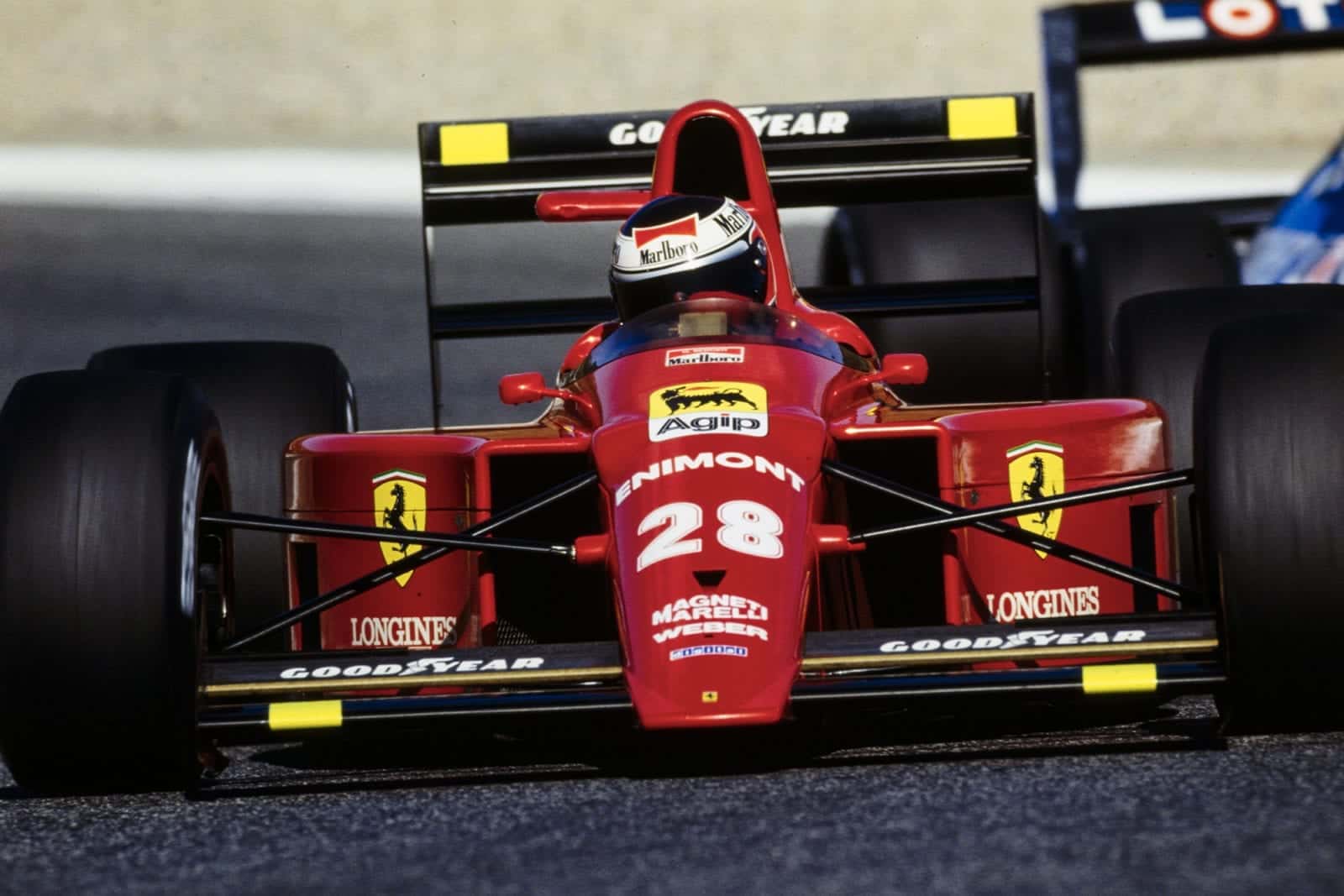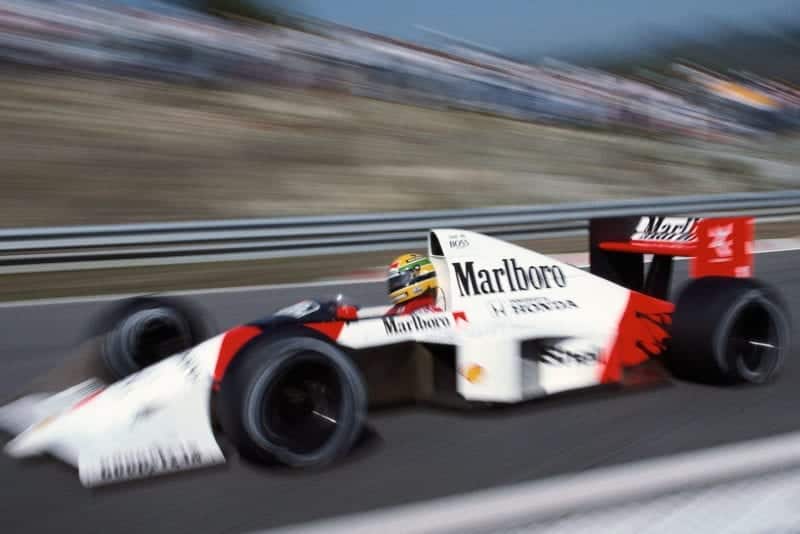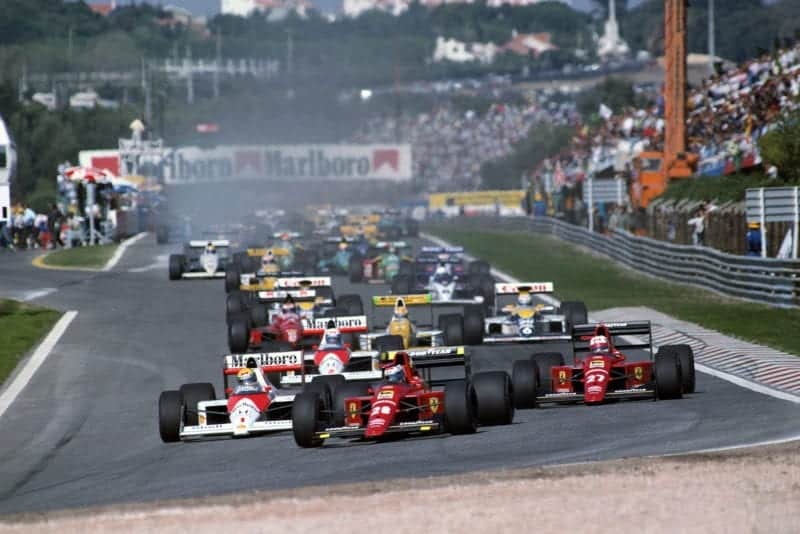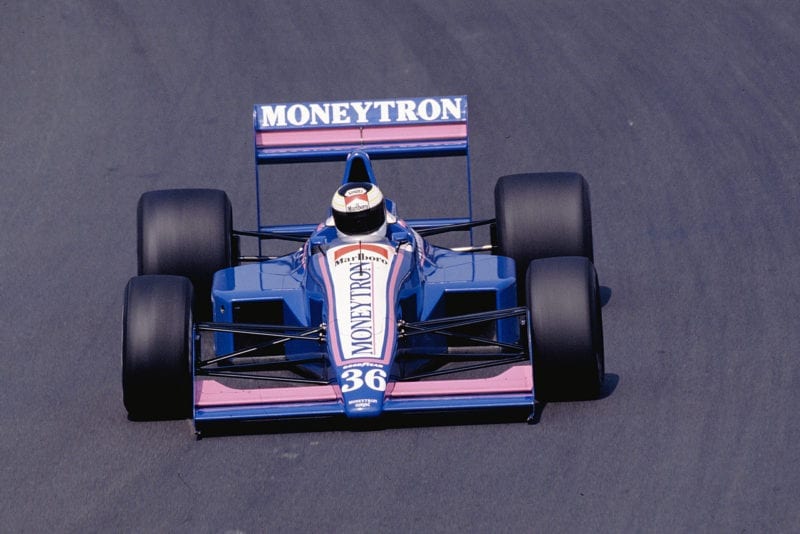1989 Portuguese Grand Prix race report

Ferrari's Gerhard Berger took his first win of the season
Motorsport Images
Sour grapes
It could have been one of his great Grand Prix wins. Instead, Portugal’s F1 round will go down in history as the first time in 1989 that Nigel Mansell made a serious mistake. It was one that cost not only him, but Ayrton Senna, dear.
The irony is that up until lap 39 it was shaping up to be the best race of the season, even more gripping than Hungary.
Senna, as ever, had been the dominant man in qualifying, staggering his rivals by breaking into the 1m 15s, two seconds under Prost’s 1988 pole time, on Friday afternoon ~ He bettered that by a fraction the following day, but by then Mansell and Berger had got into their stride with the Ferraris. In the end, it was the Austrian who edged closest to the Brazilian, with 1m 16.059s to 1m 15.468s, McLaren’s 1990 driver pairing again sharing the front row of the grid. Mansell was third on 1m 16.193s, unflustered by’the situation, but relieved not to have suffered serious injury on Friday afternoon when Christian Danner tried to park his Rial in the Ferrari’s cockpit after they tangled going into turn three. .
Senna didn’t make his usual blistering start, but Berger cleanly repeated his Hockenheim getaway to lead from Ayrton and Nigel, with fourth fastest Prost even at this early stage prepared to play a waiting game and see how things developed. As it transpired, he was making the smart move.
EmulatIng Senna’s own style, Berger ran away in the opening laps, eking out a second a lap over Senna, but the manner in which Mansell menaced the McLaren made it obvious that his qualifying feelings were being borne out.
“If Ayrton has the same margin of superiority in the race, we’ll be in trouble,” he had said on Friday, his tone implying he didn’t think he would have. And how did he feel about the race after Sunday morning’s warm-up? “On the record, we are quietly hopeful,” he’d smiled. “Off the record, bloody good.”

Ayrton Senna took pole for McLaren
Motorsport Images
And so it proved. By lap eight Senna was unable to resist Mansell’s clean slice down the inside going into turn one, and the McLaren surrendered second place. Berger was 8.26 seconds further up the Estoril highway, but had taken more out of his tyres. Initially, he’d been one of the few to opt for Goodyear’s harder compound, Bs, but had switched, like Mansell, Senna and Prost, to the softer Cs at the last minute. Now, however, he’d taken the edge off them with that hard running on full tanks, and the deterioration was beginning to make itself felt.
By lap 23 the gap between the two Ferraris was 0.73 seconds, and a lap later Nigel swept ahead. At the same time, Senna was mounting another charge, and edging closer to Gerhard. Things were simmering nicely.
Further back, Prost was still a comfortable fourth, well ahead of the remarkable scrap between Pierluigi Martini’s Minardi and its two new Williams FW13 shadows.The Frenchman had apologised openly and unreservedly to Honda (it says here) on the first day of qualifying, for his nasty comments at Monza, and said nary a word about the performance of his Specification Five RAI09E V10 throughout the meeting. However, in the race it had a slight hesitation at low revs, and as he was also coping with an imbalance created by incorrect tyre pressures, Prost was continuing to take a cautious approach. Indeed, he was the first top Goodyear runner to pit for fresh lyres when he carne in on lap 28, dropping temporarily to eighth.
Berger carne in next, six laps later, and was sent out again in a staggering 6.8 seconds after some beautiful teamwork. The next time Ferrari was called upon to perform, however, it would all go horribly wrong.
Senna came in next time round, promoting the redoubtable Martini to second ahead of Patrese, Berger, Ayrton, as he resumed after a lengthy 12.94s stop, Stefan Johansson’s Onyx and then Prost. Mansell was looking good.
He was a comfortable leader when he screamed into the pits at the end of lap 39, but then he made his first error of the year. As he came in he was going a fraclion too fast, and locked his front wheels as he tried to correct a slide just where he needed to turn right into his allocated slot. As his alarmed mechanics scattered, he took his foot off the brake pedal momentarily and restored front-end grip, but by then had jinked round his crew and overshot. For seconds he awaited the reassuring tug of his mechanics pulling him back in to place, but chief mechanic Joan Villadelprat was frantically waving them away as their hands reached out, and signalled Mansell to go round again. Instead, he selected reverse.
Back in 1983 at Hockenheim, Niki Lauda committed this cardinal pit lane sin, and was promptly disqualified. That wasn’t quite as bad as Reine Wisell at Zandvoort in 1971 when, rather than do another full lap as his Lotus 72 developed a problem passing the pits, he pulled into the pit exit and reversed back to his pit. He, too, was kicked out.
For Mansell, the penalty was the even worse, as he and Ferrari then compounded the original felony.
Unaware that he had transgressed, Mansell slammed back into the race after losing 20 seconds, and got his head down in a glorious charge that had him right in Senna’s draft by lap 45. A lap later, out came the black flag, by which time he was tucked right beneath the McLaren’s rear wing as they headed into the sun down the pit straight at 190mph.
That time around, he didn’t see the flag, and nor did Senna. Neither saw it on the following two laps either, such was the intensity of their duel.
Going down to turn one on the 49th lap, Mansell darted out of Senna’s slipstream and was fully alongside as they went into the corner. Senna, however, out on a wide line ready for his usual slingshot entry, came across regardless and clipped the Ferrari, the two instantly plunging into the gravel bed and retirement.
Those who witnessed Senna’s ruthless move on Prost the previous year recognised it again that lap, but this time Mansell was already there and from that instant on, their fate was sealed.
It was. Senna’s mistake, yet one had to sympathise, since Mansell should never have been there in the first place. In fact, the errors were evenly distributed between two of the world’s highest paid drivers, and the two current best teams. Mansell started the chain of events by overshooting his pit; Fiorio then obliged him to compound it by reversing, and Ferrari then failed to bring to his attention the fact that he was disqualified. Mansell himself, of course, failed to see the flag.

Berger leads after the lights go out
Motorsport Images
“I swear on the Bible I was so involved chasing Ayrton that I didn’t see the flag. And I swear that there was no radio communication that I was aware of.” He then pointed out how immediately he had responded when he was black flagged in Canada.
Tempers were flaming in the McLaren pit, meanwhile. “If that’s the Ferrari management’s idea of sportsmanship, maybe the management should be changed,” fumed
Ron Dennis. Creighton Brown was calling for Mansell’s licence to be revoked. And Senna went to bat days later by suggesting his overtaking move had been suicidal. Funny that, it had worked perfectly well 41 laps earlier . .
McLaren itself didn’t escape blame either. The reversing incident had occurred right behind the team’s pit wall slot, and in full view of its mechanics, yet nobody told Senna. Had he been aware of Mansell’s infringement, there would have been no need to fight him, and he could have concentrated on the chase after Berger. That crucial oversight had probably cost him his World Championship chance.
The other man most acutly aware of that was Prost, who no doubt laughed into his facemask as he drove past his team-mate’s damaged car and headed on to an easy six points. The race is not always to the fleet, as he himself had discovered at Estoril back in 1984. Say what you will about Prost’s softly softly approach, he’s done it the hard way too in his early days.
The blazing controversy dragged the headlines away from the other players. Berger would probably have been caught by both Senna and Mansell, such was their pace as they closed on him, but they made mistakes and he didn’t, and at the end of the day the man who had lost the 1987 race under pressure from Prost, proved himself the master as he took his fifth GP win.
It was a great day for Onyx too, Jean Pierre Rossem’s week had begun with the bulky Belgian firing Bertrand Gachot for public criticism of his team, and his replacement, Keke Rosberg protoge’ JJ Lehto, had impressed immediatly even though he just failed to pre-qualify. Mike Earle lost pace early on Friday, but made it up on Saturday as the Alan Jenkins designed ORE-1 proved well suited to the track.
Stefan Johansson quickly worked his way up from 12th to 8th, and the progerssed as his faster rivals met misfortune.
Willams finally debuted the FW13, and although Patrese and Boutsen found it nevous and very tricky to drive at this stage of its development, they were close to the pace. Martini, however, was not to be daunted by them in the race, and steadfastly stayed ahead of both until his tyre stop on lap 43.
In Friday’s qualifying the little Italian had devasteted his rivals with 3rd fastest time, right in the 1m 16s with Berger, and although he didn’t subsequently improve it, it still gave him 5th on the grid. He kept that slot too, at the start, and as Prost, Berger, Senna and then Mansell pitted he actually took the lead for a few gorious moments. They were moments too, since Berger was back into his stride and soon blew by again, but it was to be spoiled when his 2nd set of Pirelllis proved less grippy than the first.

Johansson made his way from Pre-Qualifying all the way to a podium spot
Motorsport Images
Into the latter half of the race his neck muscles also began to suffer, but 5th was a solid result as he trailed Sandro Nannini’s Benetton, which his fellow countryman had elected to start on Goodyear Bs. Both he and Johansson drove non-stop, Stefan’s performance being all the more meritorious since he was on Cs and made them last. All three benefited from Williams’ ill fortune. Throughout the pursuit of Martini, both FW13s had collected debris in their radiator ducts. Boutsen in particular watched his water temperature reaching dangerous levels, before having the ducts cleared during his tyre stop, but the damagehad been done on both cars. Boutsen pitted from fifth place with terminal overheating on lap 61, and the same lap Patrese stopped out on the circuit with a blown V10. After a steady run with Cs on the right and Bs on the left of his Tyrrell, Jonathan Palmer was delighted to take the final championship point after fending off the distant attack from Satoru Nakajima, who had driven strongly in his Lotus from 26th on the first lap to seventh by the flag. The Briton’s team-mate Johnny Herbert had failed to qualify as relief driver for Le Mans F3000-bound Jean Alesi, after suffering food poisoning, and Palmer’s first point since Imola went a long way to restoring his battered confidence.
Fellow Briton Martin Brundle was chasing Nakajima hard in the closing stages, but his race epitomised Pirelli’s fortunes, only Martini making any progress on the Italian rubber. His team-mate Sala and Brundle had both qualified well, as had second Brabham pilot Modena, but all three went backwards the moment the lights went green. Pressure and vibration problems ruined Brundle’s race and obliged him to stop twice, while Modena and Sala both felt their first sets of Pirellis were inferior to their second.
Nor was there any of the 1988 joy for March. Mauricio Gugelmin struggled home to 10th as the team’s, better runner and last year’s star Ivan Capelli dropped out early from 16th place with a blown Judd. Ninth and 11th places, however, brought a modicum of satisfaction for Larrousse, marking only the second time this year the team has achieved a finish, and the first with the new LC89. Alliot was lucky to miss Derek Warwick’s Arrows on lap 38 as the Englishman wandered into his path and obliged him to lock all four wheels in turn four. Derek had damaged the nose of his Arrows on the back of Sala’s Minardi, and the loss of downforce subsequently put him into the wall. He tried limping home, without success.
An accident also accounted for teammate Cheever, who had already had Roberto Moreno vaulting his Coloni over his Arrows at the end of Saturday qualifying. Neither was hurt and in the race only Eddie’s pride suffered in the last corner when the engine cut out and then cut in at an embarrassing moment.
Alex Caffi and Nelson Piquet also made contact, their clash on lap 34 dropping them from 11th and 12th places. That was itfor Dallara, which had lost the neck-braced de Cesaris with electronic failure on lap 18, while Moreno’s impressive 15th qualifying position was instantly negated in the race when the misfire that had plagued him all weekend retur’ned. There was no luck either for fellow eighth row partner Emanuele Pirro who dropped away early with a seized damper.
If it had gone its full course without incident, the Portuguese race would have been a stunner. As it was, it ended in acriniony that clouded the entire issue.

Ferrari beats McLaren for one of the few times this season
Motorsport Images
When the dust had cleared temporarily, however, the World Championship was beginning to come into firmer focus. Senna now had to win all three final events, while Prost needed to win only once or have somebody else other than Senna win.
The prospect of the departing McLaren driver taking number one to Ferrari for 1990 was enough to drive certain members of Honda’s F1 corps into apoplexy. DJT
